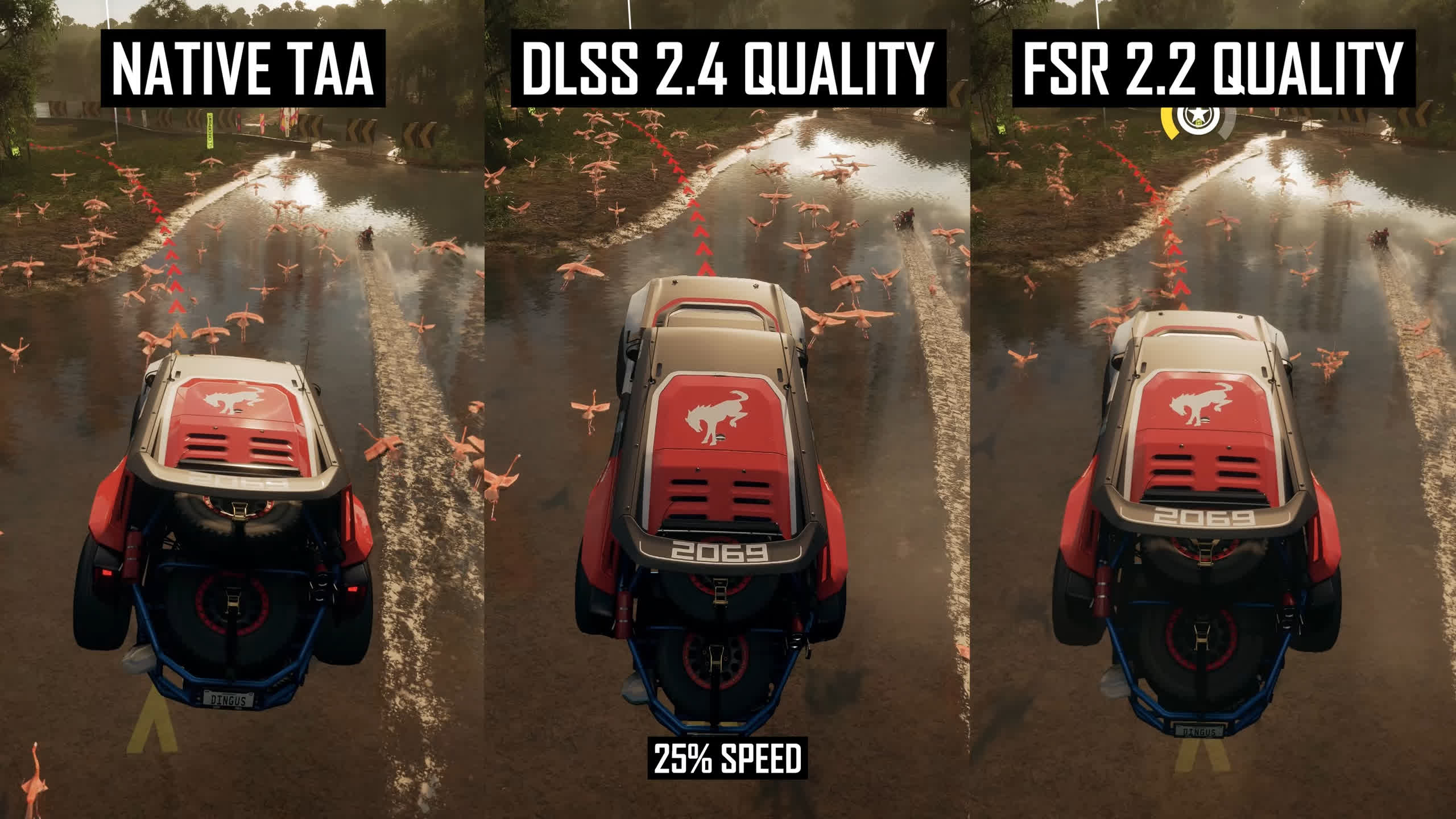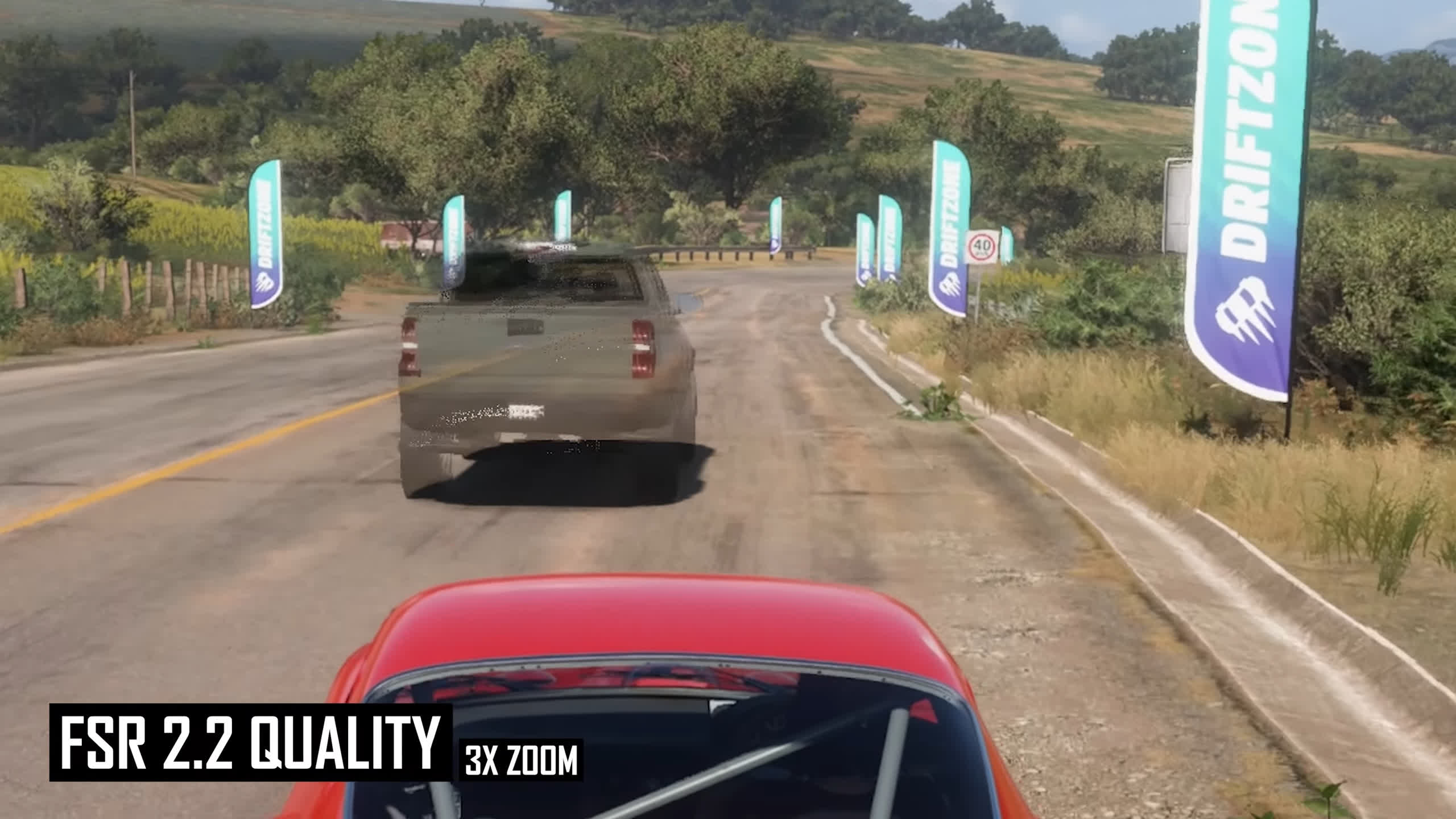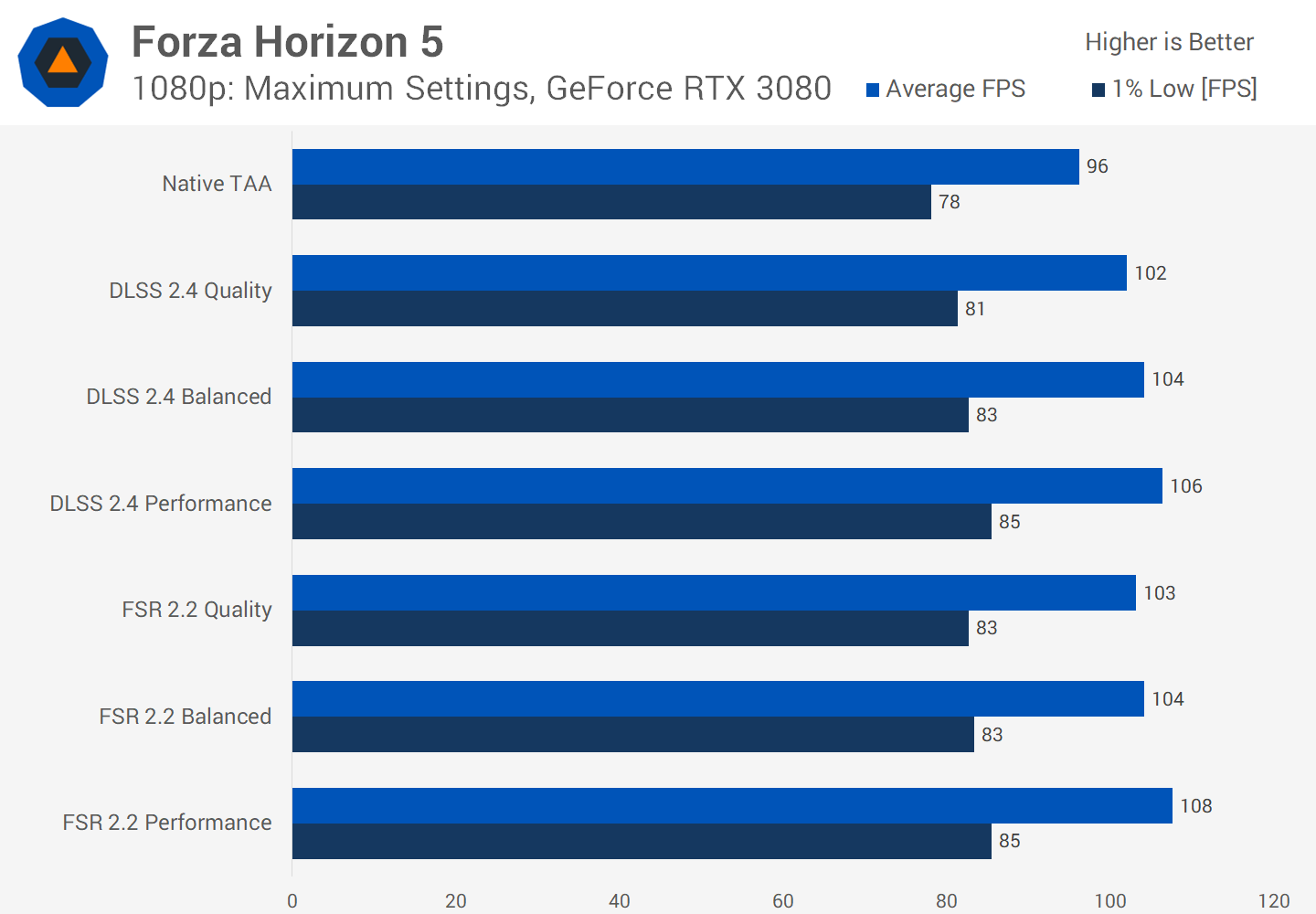We like to keep up to date with the latest in the world of upscaling, so when FSR 2.2 was brought on as part of AMD's RDNA 3 announcements, we thought it was worth taking a look and see how it compares to the latest version of DLSS.
The first game to support FSR 2.2 is Forza Horizon 5 and even though the release is light on details, the key claim is improved temporal upscaling quality with additional enhancements relative to FSR 2.1. The big talking point is that AMD claims it "alleviates ghosting on fast moving objects," which is critical for racing games like Forza Horizon, where you'll be in motion pretty much all of the time – often very fast motion with large differences between each frame.
First, a quick word on our system configuration and testing notes. We're using a Ryzen 9 7950X test rig equipped with 32GB of DDR5-6000 memory, the MSI MEG X670E Carbon motherboard, built inside the Corsair 5000D. To compare FSR 2.2 with DLSS we have to use an Nvidia GPU to gain access to all applicable technologies, so in this instance we've chosen to use the beefy GeForce RTX 4080.
The focus today will be 4K testing with a brief look at 1440p, which is where we feel upscaling makes the most sense. For the various videos we embed below (from Hardware Unboxed, of course) we highly recommend watching them at 4K, so you can see the highest quality version of the comparisons. Also, Forza Horizon 5 comes with DLSS 2.4.12, which was the most recent version when the update integrating DLSS was released.
Forza Horizon 5 Benchmark
We'll start with a look at the built-in benchmark, which runs through a city race, comparing the native TAA implementation, DLSS 2.4 Quality and FSR 2.2 Quality, all using default sharpening. The thing that was most noticeable straight away is that the DLSS image is the sharpest and we'd actually say it's a tad oversharpened using the default setting of 0.5.
For a better representation of image quality comparisons, check out the HUB video below:
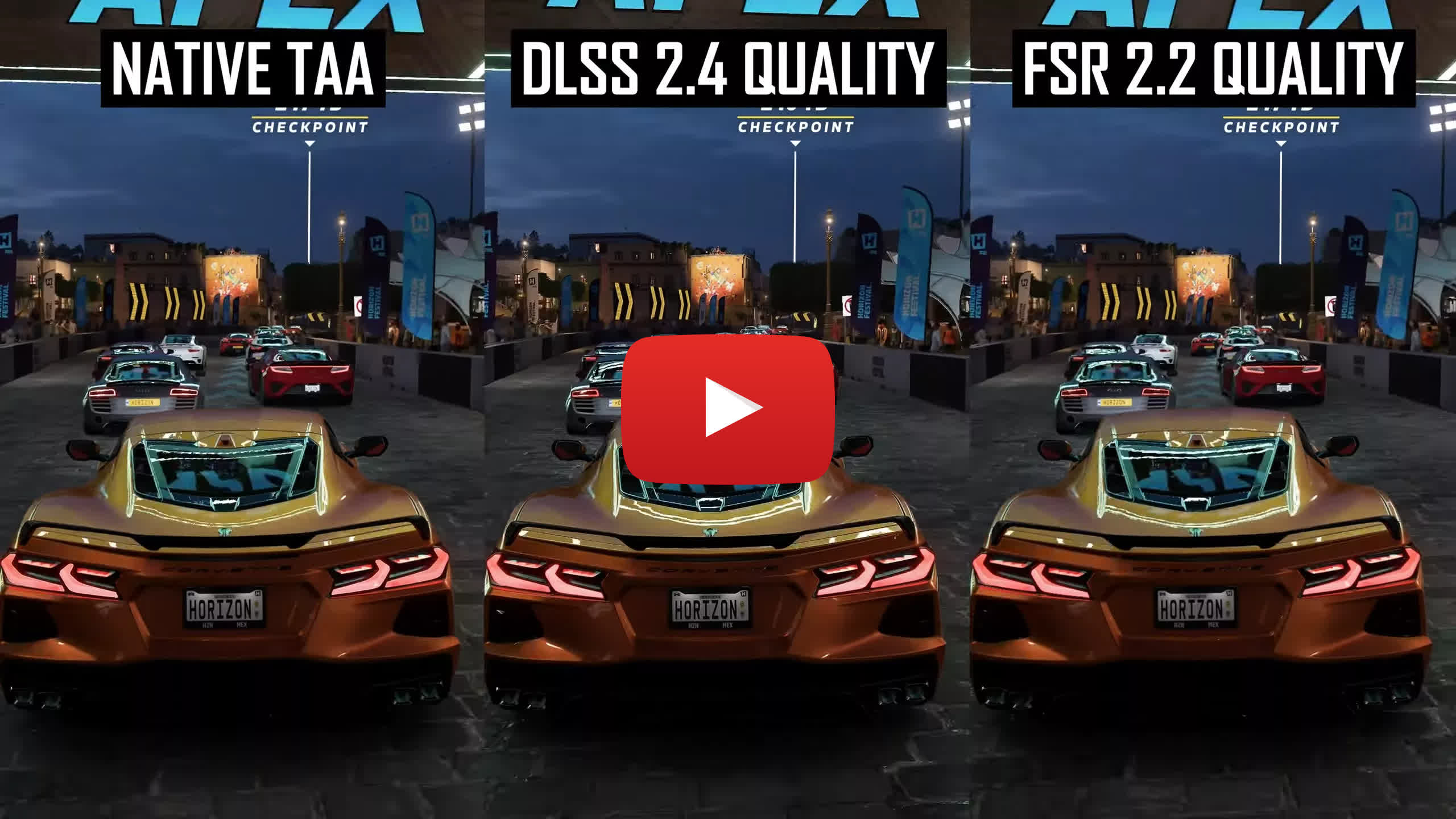
All upscaling modes and even the TAA implementation support user adjustable sharpening, but while we used sharpness of 0.5 for all modes, clearly the DLSS implementation uses stronger sharpening for each notch on the slider. This slight oversharpness isn't a big issue though, as you can tune this easily.
Right at the start of this benchmark pass, we can see a differentiating factor between DLSS and FSR. Underneath the Horizon Apex sign are some teal light strips, which are reconstructed differently depending on the technique. TAA and FSR 2.2 seem to struggle a bit with creating a clean line, so there's some aliasing and flicker here as the car moves forward.
DLSS 2.4 does a better job giving us that clean line, however this comes at the cost of ghosting, which is noticeable even using the Quality setting. None of these modes look ideal to be honest, though I tend to find ghosting very distracting, so I'd prefer native TAA.
Later in the benchmark we come to a section with overhead power lines and this is something that's quite difficult to upscale properly, especially in fast motion. Naturally, native TAA looks the best with the cleanest lines, but there are clear differences between DLSS and FSR.
DLSS using the Quality mode sizzles a bit and doesn't do an amazing job anti-aliasing the lines, at times there's noticeable gaps in the wires that change with each frame, causing some flickering, plus there's also very slight ghosting at times. On the FSR side, there's less sizzling and no visible double image in any frame, but the finest wire details are often missing here, while DLSS would attempt to reconstruct them.
FSR also had more issues when wires passed over foliage details in the background, with the foliage flickering more than on the DLSS side. I slightly prefer the FSR image as there's less sizzling, but neither reconstruction technique is doing a great job in my opinion compared to the game's native TAA algorithm.
I also spotted some ghosting in the FSR 2.2 image, which is most apparent looking at other cars at moderate distances away, where there can be some trails following those cars at times which aren't present in the DLSS image. So while DLSS didn't handle that initial light very well, FSR doesn't handle some of those moderate distance cars very well.
While FSR looks pretty decent compared to DLSS using the Quality modes, this is less true using the Performance modes. All of the issues we've just been discussing are amplified when the render resolution is lower. So on the DLSS side, the sizzling and artifacting with those overhead power lines are even more noticeable. But on the FSR side the algorithm struggles with fine wire details and at times you simply don't see the power lines at all. There's a lot of issues regardless of the upscaling technique, but it's clear that DLSS is doing a superior job of fine detail reconstruction when working with a lower render resolution. This was also the case with previous comparisons between DLSS and FSR 2, so the gap remains with this new FSR 2.2 revision.
A lot of what we've been talking about here could be described as nitpicking though as the majority of the image is very similar between DLSS and FSR, especially when using the Quality mode. Your player car, the road and other cars all look great and most of the time there is very little or no ghosting using either reconstruction technique, which is impressive given the fast motion in all gameplay.
Event with Ramp
In the next scene it's pretty difficult to spot the difference between FSR and DLSS, with minor aliasing differences between each image depending on where you look. But when we get to the ramp and jump section of this showcase event, FSR 2.2 noticeably struggles with the ramp's geometry and texture pattern. There's significant flickering here that's distracting which isn't noticeable in the DLSS 2.4 reconstruction, both using the Quality mode. I don't think DLSS looks better than native, but it looks the most similar to native TAA here.
For a better representation of image quality comparisons, check out the HUB video below:
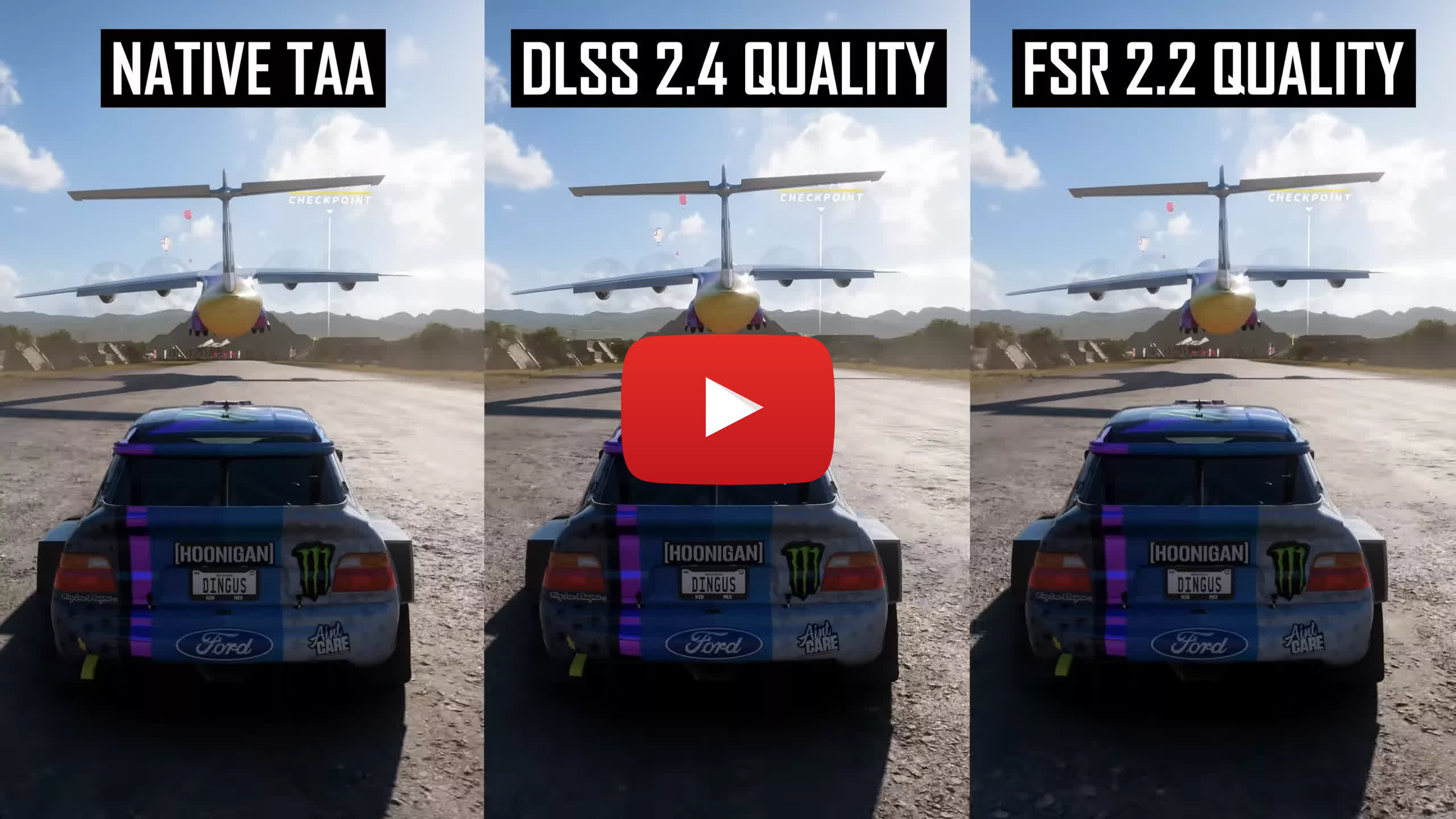
We have to focus on these occasional artefacts in games like Forza Horizon 5 because the majority of the time, there's not a lot separating DLSS and FSR using the Quality modes. In previous titles, FSR has had issues with sizzling, reconstructing grass elements and fine details. I think all of these areas are improved in this game compared to what I last saw with FSR 2.1 in our XeSS analysis, though this is just one title and we know image quality can vary with these techniques depending on the implementation. DLSS looks excellent here, but AMD do appear to be improving their tech with each release. It's just a few lingering issues like the ramp we just saw where FSR 2.2 still requires some work, as well as the Performance mode which falls away relative to DLSS.
In this next scene we're looking at a drag race and when focusing on the rear demister lines I think FSR 2.2 does a better job than DLSS 2.4 at reconstructing those fine details on a semi-transparent object in motion, getting closer to TAA. However the majority of the image is honestly pretty similar like many of these scenes, when using the Quality mode.
Focusing on the antenna array on the right side of each image, both DLSS and FSR really struggle with this particular element. The DLSS image has some sizzling and ghosting which is quite noticeable in motion that almost blurs the fine details together. Meanwhile the FSR 2.2 presentation has obvious flickering and just doesn't look as stable as native TAA. I don't have a strong opinion here on which technique does a better job as both need work. FSR is also slightly less stable when reconstructing foliage, though this is hard to spot.
When looking at the Performance modes, DLSS 2.4 struggles more with the rear demister lines, but has a clear advantage with the antenna array. Both techniques look pretty crap trying to figure out what to do with all that fine detail and I would generally recommend not using the Performance modes in this game, but if you do want to use it, the FSR 2.2 presentation has more flickering, is blurrier and just can't handle the fine details as well as DLSS for that element.
Dirt Track
The most obvious difference in this next scene is comparing the amount of confetti particle effects between the TAA, DLSS and FSR presentations right at the start.
While FSR 2.2 looks pretty similar to TAA, both appear to be rejecting some of these particles while DLSS is reconstructing them. There are of course some scene differences between each image due to the random nature of these particles, but DLSS consistently showed more particles so in that sense it is better than native for this effect.
For a better representation of image quality comparisons, check out the HUB video below:
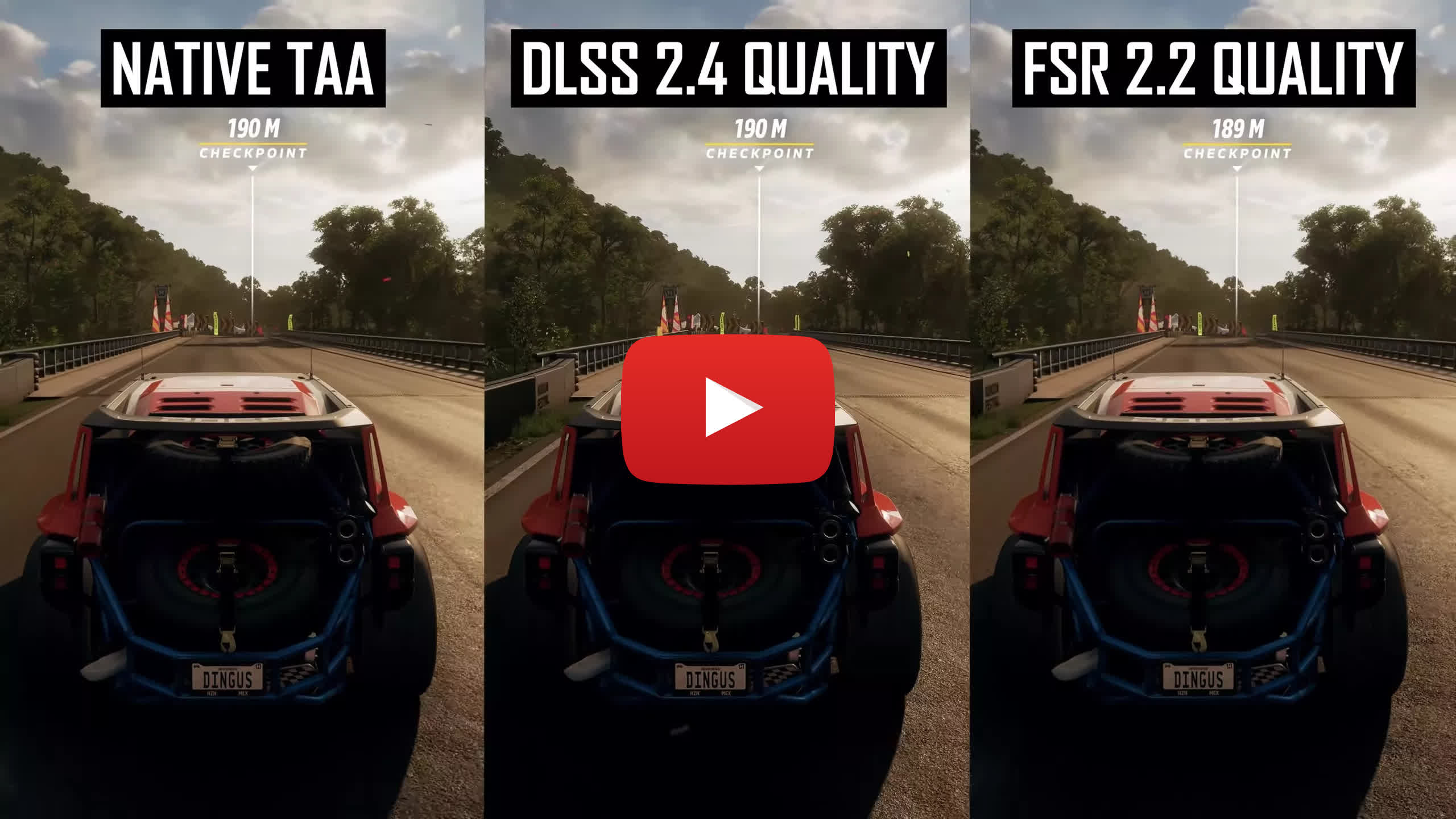
Outside of this there's nothing much else of note that we haven't described in previous segments. The foliage, cars, ground detail, wires, water effects, fine mesh, and so on are all well constructed using both DLSS and FSR in fast motion when using the Quality mode and I'd have a hard time telling which mode was being used when playing the game - outside of default sharpness differences, which are adjustable.
It's more obvious using the Performance mode, where DLSS produces a more stable image, but it still doesn't get close to native TAA when the render resolution is so low.
In this next scene, about the same things that we have been discussing. We're looking at a desert scene and the only nitpick I had was slightly more ghosting on the FSR 2.2 side during one brief part of the race, which was only noticeable when slowing down the footage.
AMD does claim ghosting has been "alleviated" for fast moving objects, which based on this and the earlier example isn't fully true from a technical sense, though you'll be hard pressed to actually spot this particular problem when gaming...with one exception and that's transparent cars.
In some sections of Forza Horizon, when you're completing tasks like drift zones, traffic will become semi-transparent, so you can drive through them and not affect your run. DLSS does a good job of handling these cars with no major issues, it looks how you'd expect it to look.
FSR 2.2 on the other hand shows a lot of ghosting and strange artifacts. We don't think the algorithm knows how to handle something like this, and the end result is quite bad, even using the highest quality mode at 4K.
1440p Image Quality
Taking a quick look at 1440p image quality, it's the same story as with 4K, but with all artifacts we've mentioned before amplified, even using the Quality mode.
So if the FSR 2.2 image flickers a bit at 4K, it will flicker more at 1440p. If the DLSS image has some sizzling on fine wires at 4K, it'll sizzle more at 1440p. As expected, the lower the render resolution goes, the more difficulty these algorithms have at reconstructing.
For a better representation of image quality comparisons, check out the HUB video below:
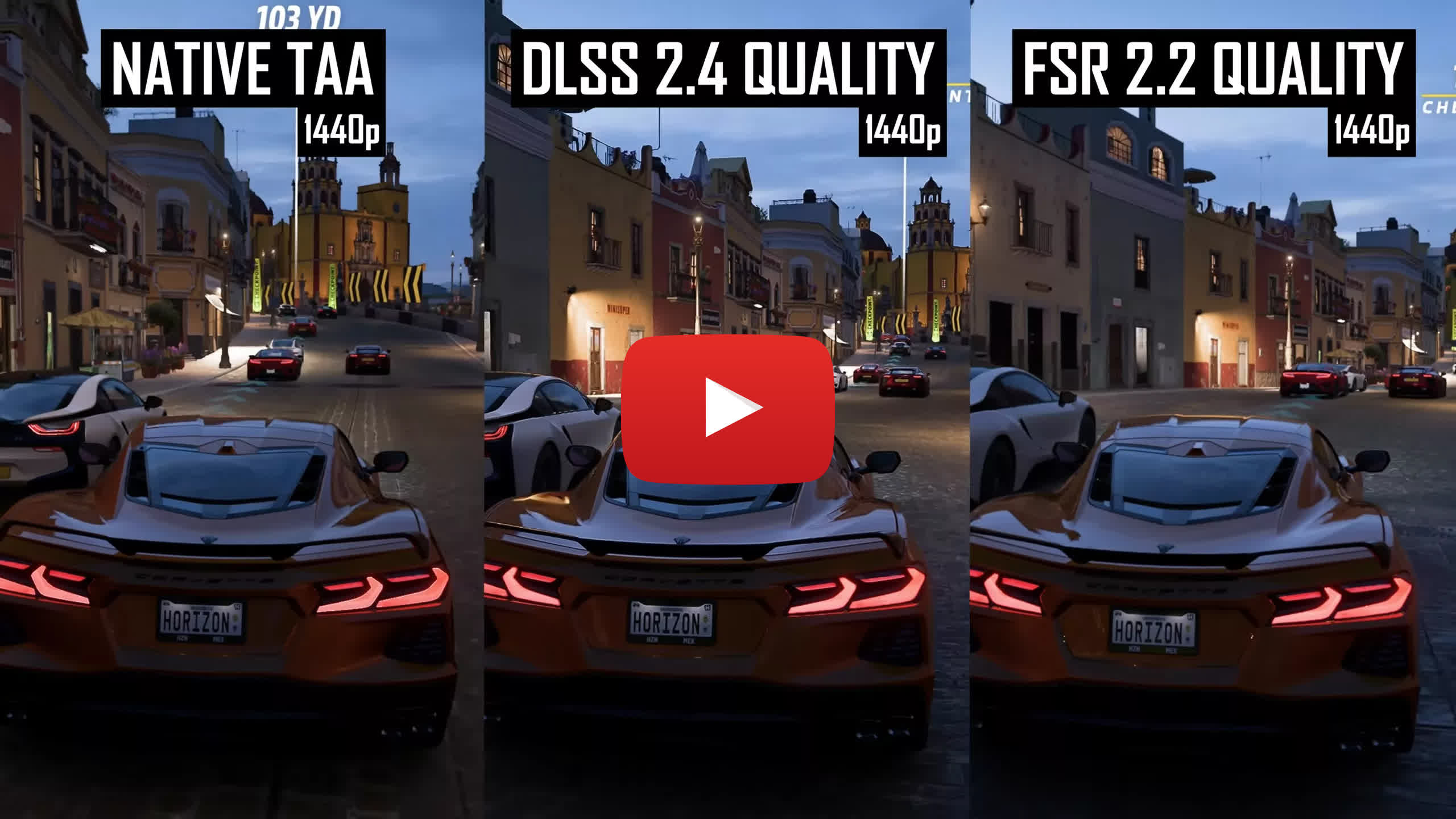
Generally speaking, we don't think FSR 2.2 is as competitive up against DLSS 2.4 at 1440p or any rendering with a near or sub-1080p render resolution.
This hasn't changed compared to our previous investigations of DLSS vs FSR, where generally DLSS gets the lead at 1440p. We don't think FSR 2.2 looks terrible at 1440p using the Quality mode, but we wouldn't want to go any lower than that in a fast motion game such as Forza Horizon 5.
I probably wouldn't recommend using DLSS lower than Quality either, and realistically in this sort of game the native TAA does look quite a bit better at 1440p than upscaling. But for those that need the performance it could be an option.
Performance
When looking at performance, DLSS and FSR performance is similar, with DLSS tending to have a slight edge at higher quality modes.
We had to swap out the RTX 4080 for an RTX 3080 here for these benchmarks, as the RTX 4080 ran into a CPU bottleneck almost immediately in the built-in benchmark when using some of the lower quality upscaling modes even with max settings. Using an RTX 3080 more appropriately shows the differences here, with a modest performance gain in this title using upscaling.
We don't think it's worth using the Performance mode from either technique even at 4K, because it doesn't provide a substantial uplift to performance compared to the Quality mode and introduces quite a few visual issues.
Then at lower resolutions like 1440p, DLSS and FSR are even less effective than at 4K - where previously we were getting around a 15 to 20 percent performance gain, we're now down at below 10%.
At 1080p it's also not that effective, and this is not CPU bottlenecked, 1080p performance is superior to 1440p and 4K, and the game was clearly GPU limited based on in-game metrics, it's just that upscaling is quite useless at 1080p and the game's performance doesn't seem as linked to resolution as some other titles are.
What We Learned
Overall it's been interesting to test FSR 2.2 but ultimately it hasn't moved the needle significantly in terms of which upscaling technique is the best. FSR 2.2 appears to have improved some of the issues with reconstruction that we described in our previous look alongside XeSS, but the gaps relative to DLSS remain in a lot of cases, especially when rendering at lower resolutions.
The good news is that the FSR 2.2 image quality at 4K using the Quality mode is impressive, with the majority of the image looking quite similar to DLSS 2.4's Quality mode and native TAA rendering.
At times, FSR does a better job of reconstructing elements than DLSS, though usually this is because the type of artifact in that situation is less noticeable than DLSS'. While my preference in Forza Horizon 5 is using native rendering with TAA - which is the most stable and least aliased in general across a variety of conditions - using FSR 2.2 is quite acceptable. I also liked that all techniques have adjustable sharpening sliders, which is a must for upscaling.
There were several occasions where I wasn't impressed with either FSR or DLSS in this game to be honest. Both techniques can produce noticeable ghosting at times, despite AMD's claims for FSR 2.2. Both upscaling techniques show a lot of artifacts reconstructing fine details in motion, common on overhead wires and similarly small or thin elements.
Shimmering, flickering, sizzling, aliasing is pretty common and obvious using even the highest quality modes, it just depends when and where you see them, which can differ between each technique. In these sorts of fast games with lots of motion, we think both AMD and Nvidia have a way to go to produce clean images in all conditions.
The main issues with FSR 2.2 come down to two areas. The first is that while both techniques do struggle in some areas, FSR 2.2 has more edge cases of poor reconstruction, like the ramp and transparent cars we showed - even using the highest quality modes. I think these edge cases have been reduced with the new revision, but there's still more of them than gaming with DLSS 2.4, even though I was hardly impressed with how DLSS looked at times.
The second is that FSR 2.2 hasn't resolved the gap between DLSS and FSR at lower render resolutions, like using the Performance mode or gaming at 1440p. Using lower render resolutions increases the amount of artifacts with both upscaling methods, but FSR suffers a heavier hit which makes image quality comparatively worse. DLSS still has a clear lead using the Performance mode at 4K, and most modes at 1440p. With that said, Forza Horizon 5 is not a good example for low render resolution upscaling, as the game is so fast that you'll see heaps of artifacts.
AMD is doing a decent job of competing with DLSS and the amount of titles that support FSR 2 these days is pretty reasonable considering it was launched only 6 months ago. But Nvidia has continued to improve DLSS 2 over the years as well, so to close these gaps we've been talking about, AMD needs to outpace Nvidia in providing improvements. Whether they can do that remains to be seen, because right now I'd still say DLSS is a selling point for Nvidia GPUs due to its superior quality and wider game support.
